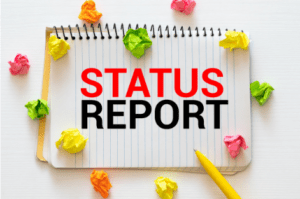Executive Summary
RAID log management and your project / RAID reviews will transform your program management and how you manage multiple project managers’ efforts. A RAID log helps you achieve the ultimate project manager badge and is an effective tracking tool for critical items. But, using your RAID can also save time out of your day for project meetings, agendas, and status reports.
- Be an Ultimate Project Manager, Always on Top of Everything!
- How to Manage a Raid Log
- Replace Your Meeting Notes, Now and Forever
- The Best Way to Provide Material for Status Reports
- Manage a Portfolio or Program?
- RAID Log is the Solution to Managing Project Risks, Actions, Issues, and Decisions
Be an Ultimate Project Manager, Always on Top of Everything!
Project management can be overwhelming. It is easy to drown in all the activities you need to stay on top of. Meetings, problems, people, deadlines. It is easy to start falling behind with all that is going on. In situations like this, your RAID log can become more than a document – it becomes a methodology.
Learning to use a RAID log will allow you to be “always-on” and up to date with your project’s progress and plans. It is a way of running your projects which can keep you focused on your schedule and keep things moving, especially when you have multiple projects going on at once.
RAID logs are simple, and an indispensable tool for managing the delivery of work, and anybody running a project should be using one. Why? Because a RAID log is:
- A tracking tool tracking operational activities related to your project, specifically; risks, action items, issues, and decisions.
- It’s a list of everything going on at this moment of your project and the activities you need to accomplish.
- A communication tool for more clearly and efficiently communicating with your stakeholders and project team members.
- The more challenging the environment, the more valuable your RAID log will become.
The more chaotic the environment is, the more critical it is to keep your log a safe harbor of clarity and simplicity. Keep it easy to use, easy to understand, light, and accessible.
How to Manage a Raid Log
The goal of your RAID log is to help you keep operationally aware and on top of your projects. It is more than a document – it is your super-power methodology.
The key is giving yourself time to review it. Reviewing your RAID log should be your quiet moment where you get your head together and plan your day or week. If you don’t plan it and time-box a part of your workweek for this purpose, RAID review is the kind of thing that gets put aside and becomes another task you fall behind on.
For best results, block out the time on your calendar, or tie it to a morning ritual like having your coffee or updating before you open your email for the first time each day. You can do it weekly, daily, or both when planning your RAID reviews. Weekly RAID Review
Weekly RAID Review
For weekly review, at the minimum, block some time on Friday morning before you open your email to review and update your RAID. This time block will allow you to make your updates from the week’s accomplishments, plan for the next week and get your updates in line for your weekly status report if you do that kind of thing.
Daily Check-In
If you go “all in” on a RAID log, go with a daily review – especially if you have a heavy project load or projects on fire. First thing in the morning, before you open your email and while your coffee is still hot, open your RAID log (or logs if you carry multiple projects) and do a quick run-through. Identify ‘must do’ items for the day and either block time for them on your calendar or write them on your to-do list or post-it notes.
Replace Your Meeting Notes, Now and Forever
The best PM I know, who introduced me to the RAID log, literally lived by them daily. Her projects of choice were challenging merger & acquisition (M&A) programs, where she worked with the leadership of different organizations to plan and implement the merging of business functions.
M&A is really tough work – executives know that not everyone at the table would have a seat at the end of the process. So, these are demanding environments to get consensus and decisions made; high stress, high stakes, and often low cooperation.
When I asked her how she facilitated these contentious meetings, she said, “I don’t use meeting notes. I use my RAID log!”
She used no meeting notes at all!
She explained, and the logic is simple:
- What are the most important things you need to capture when creating meeting notes? The actionable ones – like Issues, Action Items, Decisions, and Risks.
- When you plan and execute a meeting, what are the most important things to be discussed? Discussion is focused around – Actions, Issues, Risks, and Making Decisions.
The question then becomes; What’s left worth capturing in your notes? Not much, right?
Provide a meeting agenda and take that meeting agenda off the RAID log. Share the RAID on the projector or via Zoom. Run through the applicable Action items, Issues, etc.
And here’s the best part – making a Decision during a meeting or assigning an action item and entering it into the RAID log in real-time while everyone watches. It’s incredible how everyone pays attention more to a decision or action item that is updated in real-time with their name next to it!
Here is a quick tip: if you try to replace your meeting notes with a RAID, add a column for “Source” or “Meeting” and add the meeting name and date. This column will allow you to find which items in the log came from which meeting—a quick way to see all the Items pertinent to a particular forum or team.
I challenge you to try it! Try to run one of your regular status, governance, or planning meetings using your RAID log as much as possible. Whenever there is a new Action, Issue, or Decision, pull up your RAID log, type it out, or update it in real-time, and see how much everyone pays attention. And see how much time you save by not having to do minutes afterward.
The Best Way to Provide Material for Status Reports

RAID Log Updates for Status Reports
If you are not distributing regular status reports for your projects to your stakeholders, you should be. Status reports should, of course, include delivery progress and budget updates but should also have critical items from your RAID log. Keeping these items up to date in your RAID log means you should be able to copy and paste data from your RAID into your status communications.
Unfortunately, finding, copying, and pasting the right status items from a spreadsheet-based RAID into your status report can be difficult: how do you find the priority items, the key items raised, and new escalations? Fortunately, this is super easy with our SaaS-based RAIDLOG.com
Manage a Portfolio or Program?
A program is a project made up of sub-projects – which are sometimes called workstreams – each project is typically run by different project managers, with a program manager responsible for all projects.
Being a program manager can be challenging because you hold responsibility for this tremendous program. Still, you also must manage multiple project managers, and each PM usually has their way of doing things.
An easy way to get your PMs to manage things consistently and stay on top of how they manage their projects is to have them all use the same RAID log template.
Then you can use a RAID log review meeting to coach your PMs and keep things coordinated across workstreams. Plus, your program RAID log becomes, to a large extent, the roll-up of the RAID logs across all your workstreams.
Not only can you review the RAID logs for each workstream to keep them up to date, but you can aggregate top risks, issues, and decisions into your program’s high-level RAID log – this is where a software solution, such as RAIDLOG.com, can come in handy.
RAID Log is the Solution to Managing Project Risks, Actions, Issues, and Decisions
Save your project before it has to be rescued!
Projects don’t go wrong because of your project plan or user stories. They go wrong because of unmanaged Risks, neglected Action Items, unresolved Issues, and poor Decision making.
RAIDLOG.com is a purpose-built project management tool that is coming to market and helps you keep your RAID log simple, accessible, and secure.
Why keep struggling with a spreadsheet-based RAID log when RAIDLOG.com can aggregate data to the master RAID log, provide central reporting and access control, and is easy to use and share with project shareholders and team members.
Bring order to the chaos in your project management life!
Signup for exclusive access to the only tool that’s purpose-built to save your project before it needs to be rescued and give yourself peace of mind.
BE THE FIRST TO USE IT – FOR FREE
Join Now